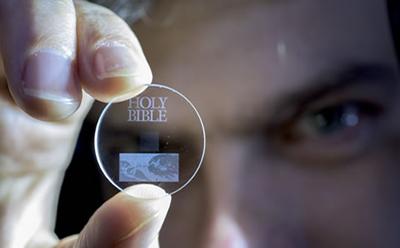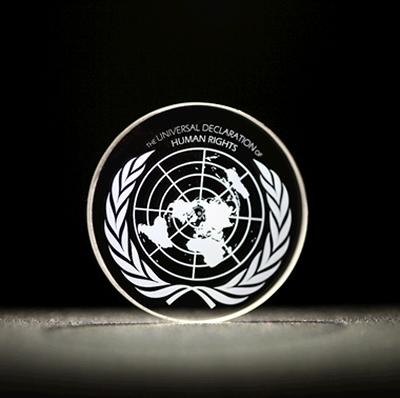[스크랩] 동전만한 유리에 CD 50만장 데이터 저장… 100억년 지나도 멀쩡
동전만한 유리에 360테라바이트(TB) 정보를 담을 수 있는 기술이 공개됐다. CD 50만장이 넘는 분량 데이터를 저장하는 셈이다.
16일(현지시각) 데일리메일에 따르면 영국 사우샘프턴 대학은 새로운 형식의 저장장치를 선보였다.
이 저장장치는 나노구조로 된 유리다. 여기에 펨토초 레이저로 정보를 기록한다. 고출력 에너지를 한 점에 집중할 수 있어 금속이나 세라믹 등 재질에 상관없이 세밀하게 가공할 수 있다. 펨토초는 1000조분의 1초를 의미한다. 세밀 가공 덕에 디스크 한 장에 360TB 정보를 담을 수 있다.
데이터는 3층으로 구성된 레이어에 기록된다. 3D 좌표에 크기와 방향으로 저장되기 때문에 5차원 데이터라고도 불린다.
사우샘프턴 대학은 “실온에서 최대 138억년간 변질 없이 저장 가능하다”며 “최대 섭씨 1000도까지 견딜 수 있을 것”이라고 전했다.
유리 디스크는 지난 2013년 시연된 바 있다.
사우샘프턴 대학은 이후 기술을 발전시켜 성경과 보편적 인권선언, 권리장전 등을 기록해 이날 공개했다.
http://www.ipnomics.co.kr/?p=41022
Eternal 5D data storage could record the history of humankind

Scientists at the University of Southampton have made a major step forward in the development of digital data storage that is capable of surviving for billions of years.
Using nanostructured glass, scientists from the University’s Optoelectronics Research Centre (ORC) have developed the recording and retrieval processes of five dimensional (5D) digital data by femtosecond laser writing.
The storage allows unprecedented properties including 360 TB/disc data capacity, thermal stability up to 1,000°C and virtually unlimited lifetime at room temperature (13.8 billion years at 190°C ) opening a new era of eternal data archiving. As a very stable and safe form of portable memory, the technology could be highly useful for organisations with big archives, such as national archives, museums and libraries, to preserve their information and records.
The technology was first experimentally demonstrated in 2013 when a 300 kb digital copy of a text file was successfully recorded in 5D.
Now, major documents from human history such as Universal Declaration of Human Rights (UDHR), Newton’s Opticks, Magna Carta and Kings James Bible, have been saved as digital copies that could survive the human race. A copy of the UDHR encoded to 5D data storage was recently presented to UNESCO by the ORC at the International Year of Light (IYL) closing ceremony in Mexico.

The documents were recorded using ultrafast laser, producing extremely short and intense pulses of light. The file is written in three layers of nanostructured dots separated by five micrometres (one millionth of a metre).
The self-assembled nanostructures change the way light travels through glass, modifying polarisation of light that can then be read by combination of optical microscope and a polariser, similar to that found in Polaroid sunglasses.
Coined as the ‘Superman memory crystal’, as the glass memory has been compared to the “memory crystals” used in the Superman films, the data is recorded via self-assembled nanostructures created in fused quartz. The information encoding is realised in five dimensions: the size and orientation in addition to the three dimensional position of these nanostructures.
Professor Peter Kazansky, from the ORC, says: “It is thrilling to think that we have created the technology to preserve documents and information and store it in space for future generations. This technology can secure the last evidence of our civilisation: all we’ve learnt will not be forgotten.”
The researchers will present their research at the photonics industry's renowned SPIE—The International Society for Optical Engineering Conference in San Francisco, USA this week. The invited paper, ‘5D Data Storage by Ultrafast Laser Writing in Glass’ will be presented on Wednesday 17 February.
The team are now looking for industry partners to further develop and commercialise this ground-breaking new technology.